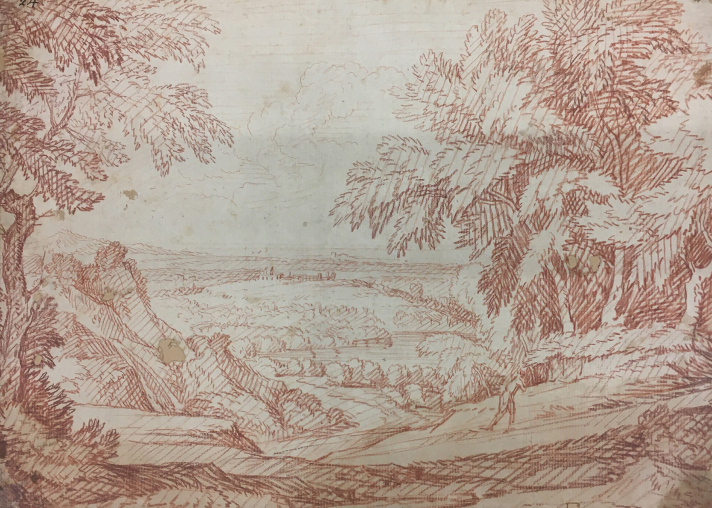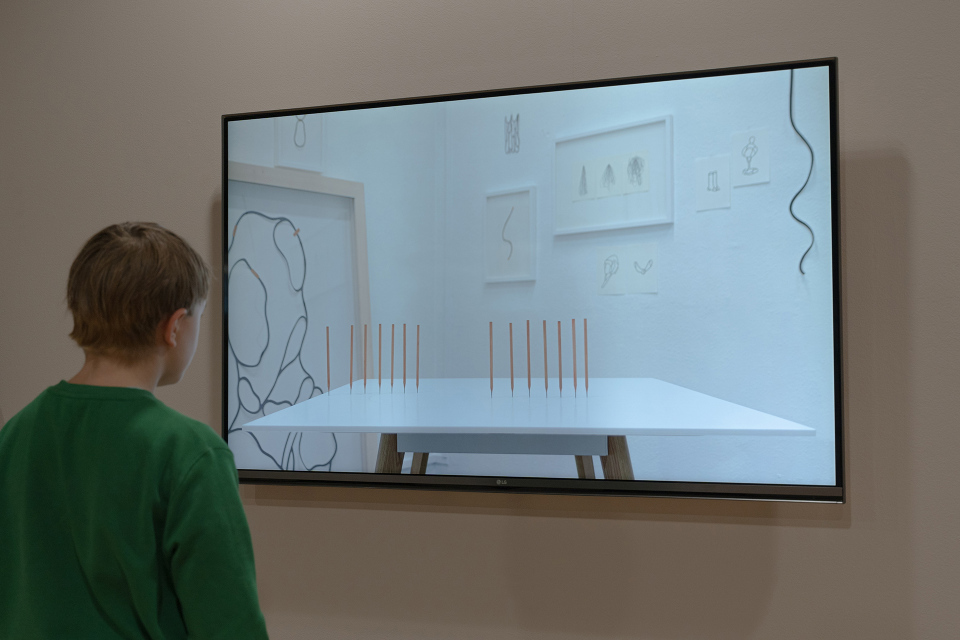"Italian Landscape" Gaspard Dughet (1635–1675) National Library of Latvia Graphic Art Collection
"Punkti kustībā"
Izstāde "Līniju arhīvs. Zīmējums un akvarelis Latvijas Nacionālās bibliotēkas krājumā” LNB Rīgā
18.09.2020.-31.05.2021.
Zīmējums uz putukartona, 24 zīmuļi, 100x140cm; animācijas cilpa
Zīmējumu veido līnijas – rokstaksta smalkākā vienība. Tonējot laukumu ar štrihu līnijas ir īsas, asas, ātras. Rokrakstu veido izvēles, kas treniņu rezultātā kļuvušas automātiskas. Ar skatienu var izsekot rokas kustībai, žestam, kuru redzamu padara zīmuļa nospiedums. Zīmējums ir būvēts no pieskārieniem.
Bibliotēkas kolekcijā ir dabas vai clvēka ķermeņa studijas, mitoloģiski sižeti. Skices, uzmetumi, kompozīcijas meklējumi, kurus autori nav paredzējuši izlikt izstādē. Aisberga neredzamā daļa, par kuru skatītājs bieži vien nenojauš raugoties gatavā darbā. Te ir gaismēnu studijas un centieni attēlot atpazīstamo vai attēlot, lai atpazītu.
Zīmējumu skatītājs un zīmētājs uztver dažādi. Zīmējot pavadītais laiks ir ne tikai treniņš, bet arī savas realitātes veidošana. Zīmēšana var būt domāšas process. Kā izskatās neredzamais? Kā radīt attēlu, kura mērķis nav attēlot dabu?
Papīrs, grafīta līnija, līnijas sākumā un beigās perpendikulāri plaknei iemontēti divi zīmuļi. Zīmulis līnijas sākumā – brīdis, kas tas pieskaras lapai, beigās – kad tas tiek atrauts no lapas.
Velkot līniju, vietā, kur zīmulis pieskaras papīram atrodas tagadnes punkts. Laika dimensija redzama tikai zīmētājai. Skatītājs nepieredz notikumu, bet uztver faktu.
/
"Points in Motion"
Exhibition "Archive of Lines. Drawings and Watercolors in the Collection of the National Library of Latvia" at the NLL Riga
18.09.2020 – 31.05.2021.
Drawing on mountboard, 24 pencils, 100x140 cm; animation loop
A drawing is composed of lines — the most basic units of handwriting. When shading a surface with strokes, the lines are short, sharp, and swift. A person’s handwriting consists of choices that have become ingrained through muscle memory from repeated practice. One’s gaze can follow the movement of the hand, the gesture made visible through the imprint of the pencil. A drawing is built from these touches.
The library collection includes studies of nature, the human body, and mythological scenes. Sketches, drafts, and explorations of compositions that the artists did not intend to present as finished works. These are the invisible parts of an iceberg that the viewer often remains unaware of while contemplating a completed piece. Here, you find studies of light and shadow, attempts to depict the recognizable, or even to depict in order to understand it.
The viewer and the artist experience the drawing differently. The time spent drawing has not only served as an exercise, but also as the creation of a personal reality. Drawing can be a process of thinking. What does the invisible look like? How can one create an image that does not aim to represent nature?
Paper, a line of graphite, two pencils mounted perpendicular to the surface, one at the beginning and one at the end of the line. The pencil at the start — the moment it touches the page, and at the end — when it is lifted from the sheet.
As you draw the line, the present moment exists where the pencil touches the paper. The dimension of time is experienced only by the one drawing. The spectator does not witness the event itself but perceives only the result.


